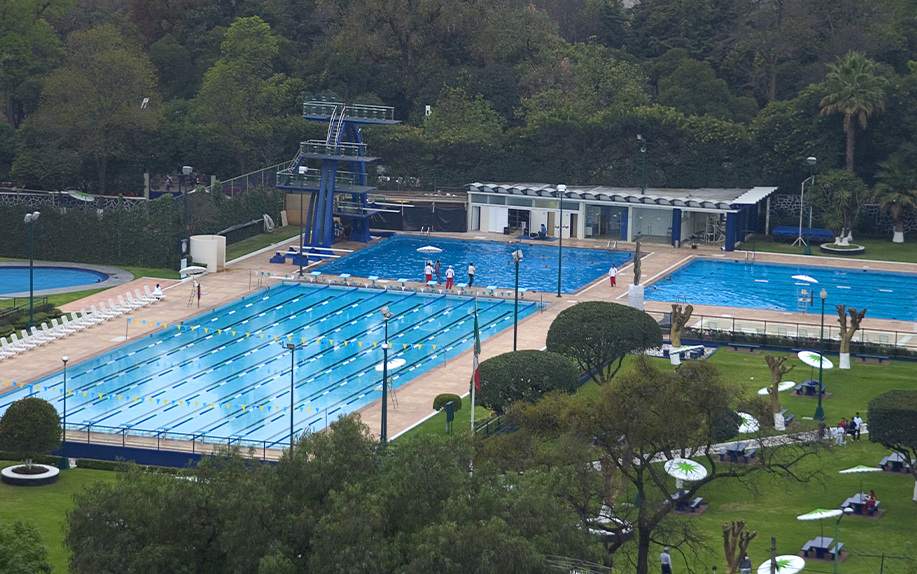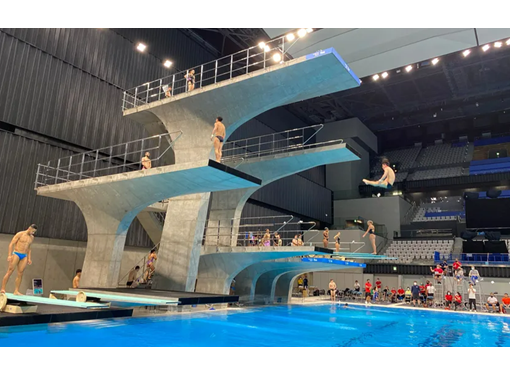What Makes a Good Competitive Diving Pool?
August 02, 2021 at 02:30 PM

Competitive diving requires immense strength, flexibility, kinaesthetic judgment, and an aquatic center that meets all the proper requirements. The diving pool each athlete practices and competes in must follow specific guidelines to ensure a competitive divers’ safety and comfort. Here, we elaborate on the design elements that make up a good diving facility.
The Perfect Diving Pool
A diving pool can be its own diving well or part of a competitive swimming pool, but regardless, here are the elements that you’ll find at a well-built facility.
1. Different types of platforms
There are two different ways of diving: springboard and platform. What separates the two is the distance above the surface and the fact that springboards are flexible “bouncy” boards, whereas platforms are static. Springboards should be set at 1-meter and 3-meters above the water’s surface and platforms should be set at 5-meters, 7.5-meters, and 10-meters above the surface.
2. Depth
Now, this is extremely important… Depth matters. Here is a simple breakdown of the minimum swimming pool depth requirement for both springboard and platform diving in an indoor or outdoor swimming pool facility:
- 1-meter springboards: 11 feet and 6 inches
- 3-meter springboards: 12 feet and 6 inches
- 5-meter platforms: 13 feet
- 10-meter platforms: 17 feet
Why so deep? It’s all about safety. Imagine you’re skydiving and jump out of a plane that is 11,000-feet in the air. You pull the parachute once you’re closer to the ground and the parachute slows you down so you can safely land. In the case of diving, the water acts as the parachute and helps slow down the divers as they are plunging into the water from 10-meters in the air, and the depth gives divers time to slow down so they don’t hit the bottom.
3. Size
The length and width of a pool designed for diving are also very important to ensure the safety of each diver. There must be enough room for each diver to perform their dive and swim back up to the surface without injury. A typical competitive diving pool measures out to be at least 50-feet long and 75-feet and 11-inches wide.
Platform Arrangements
There are two main configurations for a platform tower where the platforms are built directly above one another: the two-centerline tower and the three-centerline tower. A two-centerline tower has a 10-meter platform over the 5-meter and 1-meter platforms, while the 7.5-meter platform is over the 3-meter platform. A three-centerline tower has a 10-meter tower standalone in the center with the other platforms on either side. A three-centerline tower is used more often as it is safer, with fewer possibilities of collisions than a two-centerline tower.

A three-centerline platform used in the Diving World Cup in Tokyo, Japan.
(Image Source)

A two-centerline platform is less common than a three-centerline platform.
Image Source: Getty Images / Charly Triballeau
The proper distance between the plummet of one platform to the plummet of the adjacent platform is as follows:
- For a 5-meter platform: 2.25 meters
- For a 7.5-meter platform: 2.5 meters
- For a 10-meter platform: 2.75 meters
The Importance of Regulating Water Temperatures
The ideal temperature of a diving pool can’t be too hot or too cold, so maintaining the temperature is crucial. According to Fédération Internationale de Natation (FINA) regulations, the water temperature for diving can be between 79 and 82 degrees Fahrenheit ( 26 to 27.8 degrees Celsius). While this may seem warm, especially in comparison to a competitive swimming pool, warmer water is less dense which created less friction as a swimmer’s body moves through it.
Pool temperature regulation is important because water that is too warm or too cold yields serious hazards and consequences to the divers. If the water is too warm, dehydration and overheating can occur. When the water is too cold, it shocks the system along with lowering heart rate and increasing blood pressure.
Hot Tubs and Showers Are a Necessity
Have you ever noticed in the Olympics how divers will immediately take a hot shower and then proceed to soak in a hot tub as they await their scores? This is a common practice divers partake in so their muscles don’t tense up in between dives, especially when competing, as sometimes it can take 20 to 30 minutes between sets. Divers are constantly in and out of the water and they can get cold waiting for their next dive, so a warm hot tub to spend the duration helps keep their muscles limber so they can produce the power and agility needed with each dive.
It is advised to have a hot tub and hot showers in close proximity to the pool, about 10 feet or less, for quick access.
Focus on the Dark-Colored Bottom
With all the flipping and rotating divers do, it can be difficult to navigate which way is up or down. Like dancers, divers need something to focus on to help them maintain their bearings while they’re performing their dives. To provide contrast between the sky or ceiling, the best competition diving pools have a dark-colored bottom, such as dark blue or black, with white walls.
Most codes require that pools have a white bottom so lifeguards can easily see the pool floor. However, most health departments will grant a variance on this regulation if the dive pool is used specifically for dive training and competition and is classified as a special-use pool.
Break the Surface with Agitators
Maybe you’ve seen water sprinkled on the surface of a diving pool during the Olympics and asked yourself, “why do they do that?” This is a form of mechanical, or water-surface, agitation. Agitators are used during competition to break up the reflection of the ceiling or sky in the water so divers can spot the surface of the pool more clearly. Water-surface agitation helps divers with depth perception when they are launching themselves from a high platform. Agitators are typically installed under all platforms and springboards where water is fed into the mechanism by a recirculation pump.
The More You Know
All of these design elements support a successful dive competition or training and give divers peace of mind when stepping up to the platform. Now that you know what makes a well-equipped diving pool, you can impress your friends with your newfound knowledge while watching the Olympics.